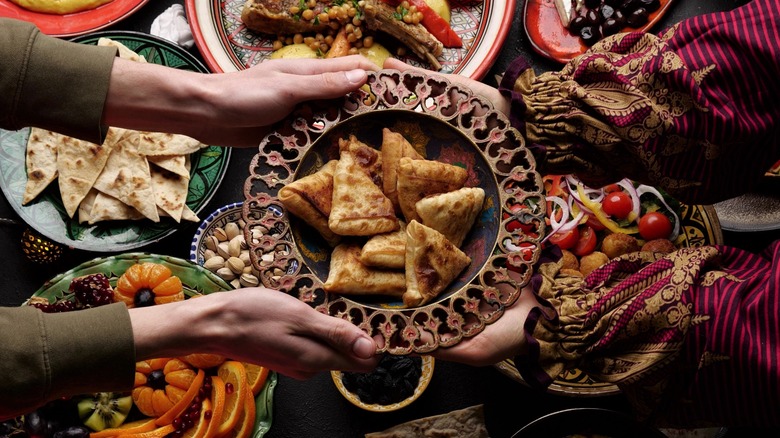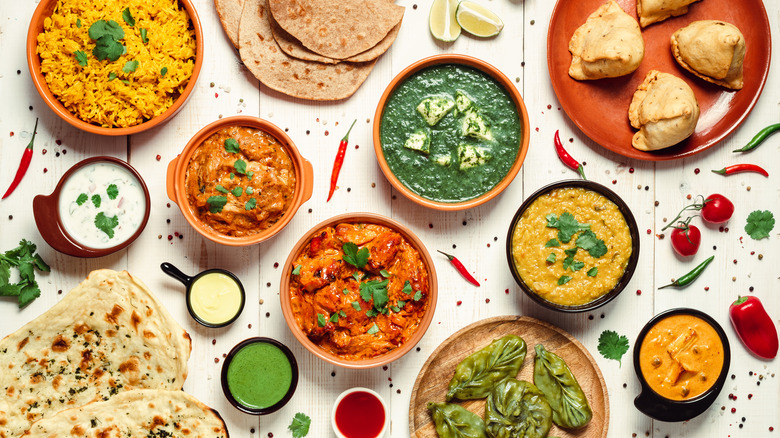Brighten Your Diwali Celebration With Some Golden Flaky Samosas
Diwali, the Hindu festival of lights, is about more than the victory of light over darkness, as enacted by Lord Rama's victory over a demon king. It's also, like so many autumnal celebrations, a time of fellowship and feasting. If you're new to Indian cuisine and want to put another arrow in your culinary quiver, try making (or at least eating) one of the most delectable of Diwali's food traditions, samosas.
Samosas are fried pastries stuffed with savory fillings and spices. They're flaky, aromatic, and unutterably delicious when dipped into various chutneys made from tamarind or cilantro. Enjoyed all over South Asia, the most familiar version is probably aloo samosas. These palm-sized, potato and pea-stuffed triangular-shaped snacks are offered in nearly every Indian restaurant. As samosas are a versatile dish, the pastries come in various sizes and can be filled with minced fish, lamb, or cauliflower, depending on the region.
Why samosas perfectly suit Diwali traditions
Although the food most associated with Diwali is known as mithai, a catch-all term describing a variety of mouthwatering sweets, savory snacks are also a festival tradition. Samosas are relatively easy to make and thus are an ideal party appetizer or part of a multi-dish banquet table — fantastic for a celebration so focused on feasting. Because of their compact nature (essentially self-contained meals unto themselves), samosas fit right into gift baskets alongside the ubiquitous mithai. And, although sweets are the star of the Diwali show, a few other savory snacks besides samosas share the spotlight.
Two prime examples are pakoras and puri. Pakoras are chickpea batter-fried crispy fritters made out of a variety of vegetables, from onions to spinach to sweet potatoes. Puri is a type of flaky, pillow-shaped bread fried in ghee, the term for Indian clarified butter, which is used for numerous culinary purposes as well as to light lamps during this holy festival as a sacred act. Samosas can also be fried in ghee, which serves a dual purpose, as this ingredient is also incorporated into the pastry's dough to guarantee maximal flakiness.
Samosas are the perfect introduction to Indian food
If you want to try making samosas at home, the experience will be like learning to cook almost every other Indian dish: rewarding but requiring plenty of preparation. The process involves several different ingredients and steps, none of which are particularly challenging, even for novice home cooks. You might need to procure a few specialty items not typically found in most domestic grocery stores and possibly familiarize yourself with one or two new cooking techniques. It's no big deal: All you're making is a savory steamed potato and pea filling with aromatic spices and a dead simple pastry dough to envelop it. The results will be sublime.
Since samosas are subject to regional expression, learning to make different types is a perfect introduction to South Asian cuisine. A Bengali samosa variant called singara is a little sweeter and nuttier, incorporating earthy notes of cauliflower along with the potatoes and peas. Keema samosas from Pakistan contain ground mutton or lamb and fresh herbs. The same basic samosa recipe was mentioned as a Delhi court favorite in writings from the year 1300, which is reason enough to make a new batch and keep the tradition alive.


